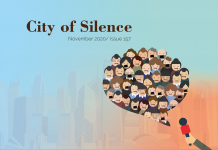Adam Ng Ying-yung, the association’s executive, says the views of the deaf are often overlooked because they cannot express their thoughts and are considered a minority. People tend to forget that visuals and images are the strengths of the deaf.
Ng says the film festival increases peoples’ awareness of the deaf and audiences can better understand their needs and culture. “Even if the deaf are just a minority, they are still part of the society; we should not neglect their needs,” Ng says.
The HKIDFF showcased films related to the deaf from across the globe, including Malaysia, South Africa, Britain and the United States. The films are not silent movies, they also feature dialogue and soundtracks but they are made by deaf people, feature deaf people and deal with deaf culture.
Among the movies shown at the HKIDFF, there were also productions from Hong Kong, including Reasons for Learning Sign Language – for Deaf People and Deaf Kid Not Stupid. Both films deal with the problems deaf children face when they have lessons using spoken language. “All deaf people are required to learn by lip reading. And sign language is banned at school,” says Kong Wan-ki, director of Reasons for Learning Sign Language – for Deaf People.
Deaf people who view deafness as one kind of human experience, rather than as a disability that needs to be fixed, identify themselves as Deaf with a capital “D”. Sign language is a central foundation of Deaf culture and Deaf identity.
One of the difficulties in organising the HKIDFF was the translation of sign language. As Ng explains: “There is not a universal sign language, so different countries have their own version of sign language.”
When a foreign deaf movie does not have English subtitles, the organiser has to translate the foreign sign language into Hong Kong sign language, before further translating it into written Chinese or English.
Director Kong Wan-ki thinks subtitles should be used to enhance the experience of films for the deaf. Kong says there should be subtitles to indicate music and other background sounds when there are no lines of dialogue. Since the deaf do not learn language in spoken form but in written form, the subtitles should be in the form of written Chinese for the convenience of local deaf audiences.
Kong cites the example of Japan. To avoid confusion, Japanese television programmes use different coloured subtitles to help differentiate the lines of different characters. Each character’s lines are also placed near to him or her to make it easier for the deaf to follow the conversation.
It would only take a bit of effort to make films more enjoyable for the deaf but it also requires a change in mindset. Xavier Tam Siu-yan, vice-chairperson of the HKIDFF Organizing Committee, believes society should stop forcing deaf people to conform to the norms of the hearing. For instance, he says the banning of sign language in schools is a manifestation of oralism and audism.
Audism highlights the importance of hearing and advocates the banning of sign language. The hearing use whatever means to “help” the deaf hear. Oralism is the idea of advocating the use of lip reading and speaking.
Tam believes that both of these ideas are myths which force the deaf to “join” the majority. It is a false hope for them to become “normal”. Supporters of the HKIDFF hope that similar events will help not just the deaf, but also the hearing to step out from the shadows of oralism and audism.










































